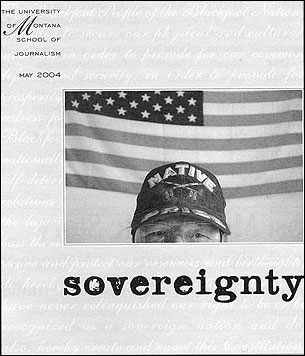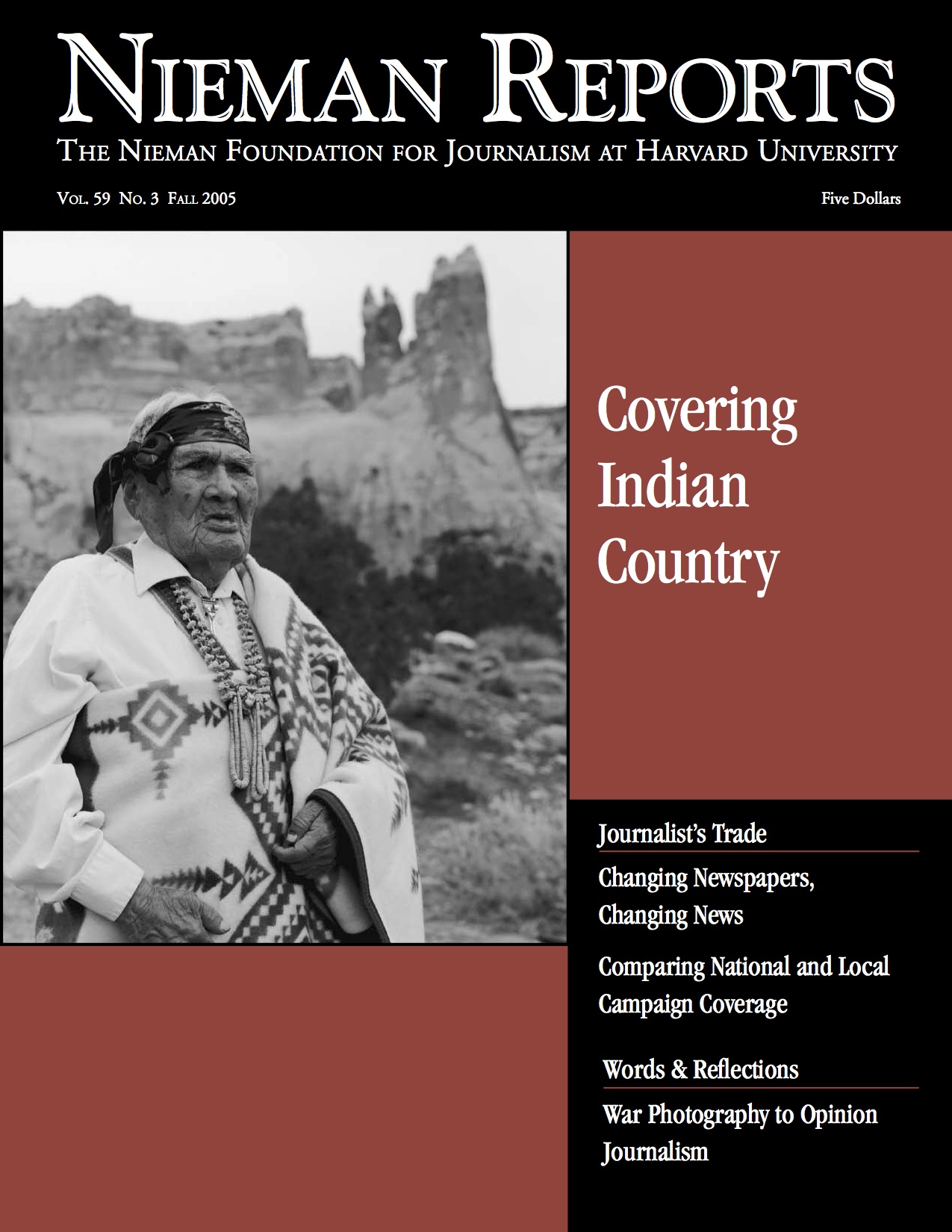Not long after graduating from journalism school, I was assigned to cover federal district court in western Montana. In reporting a trial about a man charged with an Easter Sunday murder of a family member, I described him as a 24-year-old Indian. The next day the publisher relayed to me a question he’d received from a reader: “Why had I identified the defendant by his race?” I was flustered, but stammered an answer: It explained to readers why the case was in federal, not state, court, since the federal courts had jurisdiction over crimes committed by Indians on the state’s seven reservations.
While the factual context was true, few readers would understand the distinction, or care. The real reason I described him in the way I did was because I’d grown up in Montana with Indians identified by race in the newspapers. Though Caucasians were not similarly identified, the disparity was lost on me. Thirty years distant, it’s hard to fathom, but at the time I hadn’t thought about why this different treatment constituted racism. Nor had I been exposed to its inherent unfairness when I studied journalism in college.
More than a decade later, a few years after I’d joined the faculty at the University of Montana School of Journalism, Dean Charles Hood proposed a class in which students would report on issues of concern to Montana’s Native Americans. He thought, and I agreed, that news stories about Indians in the region generally fell into two categories: coverage of crime or culture. Indeed, plenty of stories told of Indians in trouble with the law, and lots of others explored the culture of the powwow, in which Native Americans dress in the clothing of their ancestors and celebrate important traditions. Such stories served only to reinforce the perceptions most Montanans held of Native Americans, regarding them as either criminals or icons of a bygone era. Most stories were reactive, rather than being proactive, and few examined in depth many of the contemporary issues the state’s 60,000 Indian residents confront.
Today Native Americans make up about seven percent of Montana’s one million people. Caucasians comprise almost all of the state’s remaining population. Not surprisingly, few students at the University of Montana see students who look different than they do or have different ethnic backgrounds. Even in the journalism school, where half of the students come from out of state, most have almost no experience dealing with unfamiliar cultures.
Training the Students
As we thought about training these prospective journalists, we wanted to give them the opportunity to report on Native cultures they knew little about. To do this, we would need to teach them to learn how to look beyond the obvious. Learning cultural sensitivity in doing this particular assignment would translate into understanding other perspectives as they go on in their journalism careers to cover a broad range of issues involving race and ethnicity. One advantage we brought to this endeavor was being at a school where students are taught by professors who have worked for many years as journalists, and a lot of them return to newspaper work during the summer months. They are able to provide students with the guidance they need to cover real news stories and to offer extensive critiques of their work.
When we began this Native News Honors Project in 1991, we invited students who’d performed the best in other journalism courses to take this class. Photojournalism professor Patty Reksten and I limited the class to seven reporters and seven photographers and paired them in teams. We emphasized that the reporters and the photographers were equal partners in doing the research and the reporting. Reporters were not allowed to talk about “my photographer,” as if the photojournalist was the reporter’s chattel. Each team was assigned to one of the state’s seven reservations. After we selected a topic, each team began to research it at their particular reservation.
Most of our time was spent meeting individually with the student teams to discuss their progress. The most relevant advice we gave them was to find stories that could be told through the personal experiences of those affected by what their research had revealed. We did not want them to write policy stories that no reader would plow through.
Reksten showed the students, both photographers and reporters, the work of distinguished documentary photographers, and I discussed great narrative writing. The student reporters brought in writing they particularly admired and read it aloud and talked about why it was effective. After a few years of teaching the class, we added student copyeditors, photo editors, and designers to the class. Through the years, we’ve also had a number of Native American students who provide especially beneficial insights. We also invite guest speakers to discuss with students the history of American Indians in Montana and ask Native guests to guide us in interacting with Indian sources. (Reksten has left Montana to become director of photography at The Oregonian, but her successor, photojournalism professor Teresa Tamura, continues to get stunning photojournalism from the students.)
In this class, we permit students to do things we would not encourage, or even allow, in public affairs reporting classes, such as occasionally letting students stay in the homes of sources on the reservation. When a source invites them to dinner at their homes, we tell them that they can accept. In keeping with Native cultural tradition, we encourage students to bring small gifts when they go to the reservations and to give them to those who are helpful to them. We also caution them to be open to new perspectives and not make judgments about people and events based solely on their own experiences.

The cover of the 2004 Native News Honors Project.
Opportunities and Obstacles
Sources on the reservation are largely open and candid, and they seem pleased that someone in the media is showing an interest in their concerns. But research and reporting has not always been easy. Many sources don’t have a telephone, yet our students need to do their initial research from our Missoula campus, firming up their story ideas from afar. Once a team is given approval to pursue a story, they travel to their assigned reservation, which can be more than 500 miles from Missoula, to report and photograph their stories. If the original story idea falls through, students must scramble to find another. Not one student has ever come back empty-handed.
The work the students in our first class produced was extraordinary, and their successors equal that high standard. The stories are not flattering, sympathetic puff pieces. They are hard-hitting, insightful and in-depth stories about people whom the students spend time talking with and observing. Mindful of the many criticisms that Indians have voiced of anthropologists who “used” them for their studies, yet failed to share with them their findings, we require students to get the names and addresses of every source and make sure a copy of the publication is mailed to them.
In May, last year’s class of students won a Robert F. Kennedy Journalism Award for their coverage of sovereignty, which was published in 2004. It was our school’s first submission to this contest, but through the years many of the Native News Honors Project students’ stories and photos have received awards from the William Randolph Hearst Journalism Awards Program and from the Society of Professional Journalists.
In looking at how sovereignty issues affect those who live on tribal reservations, one student, for example, examined how a tribal court judgment of $250 million against the Burlington Railroad seemed like a victory for the families of three women killed at a railroad crossing, but resulted in a loss of sovereignty for the tribal court. Another student wrote about how close relationships on the reservations can lead to preferential treatment of defendants by judges with little legal training. And another student explored how problems, such as mold at tribal houses, which was allegedly making residents sick, led to confusion and inaction as the tribe and federal government could not agree on who was responsible for making necessary repairs.
In the course of publishing these stories, we’ve had to overcome some obstacles. The project is expensive, since the journalism school pays for students’ costs to travel to the reservations, where they stay four or five days. But the most significant expense is printing cost for the publication. For several years, we published the 36-page report as an insert in the Missoulian, the local newspaper. It was financed through support from the journalism school, as well as the University of Montana and other donors, such as former NBC News anchor Tom Brokaw, who has a second home in Montana. Grants from the Knight Foundation have been our mainstay and recently allowed us to insert the report into the Missoulian, the Great Falls Tribune, and the Billings Gazette, the three leading papers in the state. In doing so, this assured that most Montanans have access to it.
RELATED ARTICLES
Read Anne E. Pettinger’s story “A Student’s Most Memorable Story” for more detail on her reporting and responses her story received. »
“Finding a Different Path Into the Newsroom”
– Denny McAuliffeIn doing this project, the students learn a lot, as do their professors. An important lesson I learned early in the project was to let students have a hand in the stories up to publication. In the beginning, I rewrote the stories of those few students whose writing fell short of my expectations. After a student stormed into my office and shouted, “You destroyed my story!” I learned to use a lighter hand. I also learned to mentor rather than to dictate. With tight deadlines it is sometimes difficult to let the students do another rewrite, but it’s critical to the learning process. When I finally work on the last edit, I sit with each reporter and go over every line to make sure both of us are happy with what will be published.
Our stories don’t always make our sources happy. Our spring semester class took on the topic of race. One eye-opening story reported by a student, Anne Pettinger, who went to a northern Montana town that borders a reservation, caused such a stir that the town’s local paper wrote several stories about the residents’ reactions to it, and many efforts were undertaken to change the tense climate of race relations.
These sorts of results are ones that might not be expected from a major newspaper, let alone university students’ work. This experience offered invaluable lessons for our students in understanding the power of accurate and moving reporting and photography.
Another initiative of our journalism school involves the creation of reznet by Denny McAuliffe, an Osage tribal member. McAuliffe acts as editor and coach for tribal college reporters across the country whom he recruits to cover their campuses for this online news forum.
The Native News course is taught each year, and each class of students continues to surpass our initial goals. Most satisfying is that the majority of journalists covering American Indian issues for Montana newspapers today are veterans of the class, putting the lessons learned to use in their daily reporting. The result is stories that reflect with sensitivity and accuracy the lived experiences of Native American people.
Carol Van Valkenburg is a journalism professor at the University of Montana School of Journalism where she directs the Native News Honors Project. That project is on the school’s Web site at www.umt.edu/journalism under Student Work.


